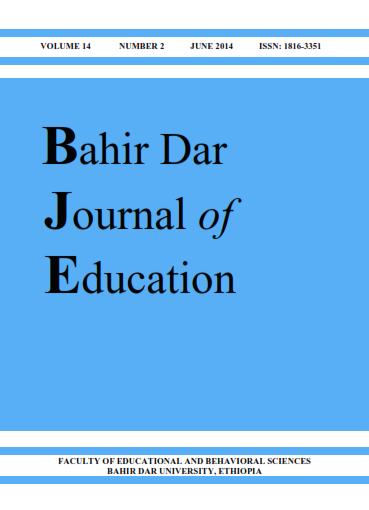Primary School Teachers’ Conceptions and Perceived Practices of Problem-solving Method in Selected Schools in Bahir Dar
Abstract
This study examined teachers’ problem-solving conceptions and their perceived classroom practices. Nine teachers were purposely selected from two primary schools. Data were collected through in-depth interview and open-ended questionnaire, and were thematically categorized and analyzed. Results showed that teachers associated the method with various issues often unrelated to it and their perceived practice was consistent with their conceptions though their conception was different from problem-solving method. Teachers confined their perceived classroom activities to discussion of factual ideas. They often equated problem-solving with use and production of teaching materials, with group discussion and as a mechanism to alleviate students’ social problems. The results implied that though what teachers claimed as their perceived use of problem-solving method is in tune with their conception, neither their conception nor their perceived practice concord with procedures of problem-solving method. Finally, implications have been drawn on the basis of the findings.References
Akalewold Eshete. (2005). The state of problem-solving skills in general secondary biology laboratory activities. The Ethiopian Journal of Education. XXV(2), 87-118.
Azeb Desta. (1995). The development of problem-solving skills in teaching and learning: strategies and techniques. Educational Journal, 2(2), 81-109.
Becker, J., & Shimada, Y. (1997). The open-ended approach: A new proposal for teaching mathematics. Reston, VA: National Council of Teachers of Mathematics.
Bhutani, K., Ramachandran, K., Beena, C., & Sen, M. (1999). Understanding psychology of human behavior. 5 th ed. National Council of Educational research and training. New Delhi, 125-139.
Buchanan, N. K. (1987). Factors contributing to mathematical problem-solving. performance: An exploratory study. Educational Studies in Mathematics. 18(4), 399-415.
Burkhardt, H. (1988). Teaching problem-solving. In H. Burkhardt, S. Groves, A. Schoenfeld, & K. Stacey (Eds.), Problem solving-A world view. Proceedings of the problemsolving theme group, ICM 5 (pp. 17-42). Nottingham, England: The Shell Centre for Mathematical Education, University of Nottingham.
Chapman, O. (2005). Constructing pedagogical knowledge of problems-solving: Preservice mathematics teachers. In H. L. Chick & J. L. Vincent (Eds.), Proceedings of the 29th PME International Conference, 2, 225-232.
Creswell, J.W. (1998). Qualitative inquiry and research design: Choosing among five traditions. Thousand Oaks, CA: Sage.
Cronin-Jones, L.L. (1991). Science teacher beliefs and their influence on curriculum implementation: Two case studies. Journal of Research in Science Teaching, 28, 235– 250.
Dawit Mekonen. (2001). The impact of the New Primary School Curricula on teaching Practice: Role relationships of students and teacher, and student’s learning behaviors: Teachers’ and students’ views in Amare et al (Eds.) Quality of primary Education in Ethiopia proceedings of the National conference held in Adama Ras Hotel, Nov 911,2001. IER, AA.
Dawit Mekonen. (2007). Evolution of aim of education policy into curricular materials and the status of teachers' awareness and classroom practice. The Ethiopian Journal of Education, XXVII(2), 25-63.
DeLuca, V. W. (1991). Implementing Technology Education Problem-Solving Activities. Journal of Technology Education, 2(2), 1-10.
Freire, P.(1970). Pedagogy of the oppressed. New York: Herder and Herder.
Fullan, M., & Hargreaves, A. (1991). What’s worth fighting in the school? Buckingham. UK, Open University Press.
Fullan, M. (1993). Changing Forces: Probing the Depths Of educational Reform. London: The Falmer Press.
Hiebert, J., Carpenter, T.P., Fennema, E., Fuson, K.C., Wearne, D., Murray, H., Olivier, A., & Human, P. (1997). Making sense: Teaching and learning mathematics with understanding. Portsmouth, NH: Heinemann.
Hoosain, E. (n.d.). What are Mathematical Problems? Agugusta State University. Retrieved June 10, 2014 from http://www2.hmc.edu/www_common/HMNJ-OLD/hoosain.pdf
Karaagac, M., & Threlfall, J. (2004). The tension between teacher beliefs and teacher practice: the impact of the work setting Proceedings of the 28 th conference of the international group of for the psychology of Mathematics Education, vol.3, pp. 137.
Kesler, R. (1985). Teachers' instructional behavior related to their conceptions of teaching and mathematics and their level of dogmatism: Four case studies. Unpublished Doctoral Dissertation, University of Georgia.
Authors who publish with this journal agree to the following terms:
- Authors retain copyright and grant the journal right of first publication with the work simultaneously licensed under a Creative Commons Attribution License that allows others to share the work with an acknowledgement of the work's authorship and initial publication in this journal.
- Authors are able to enter into separate, additional contractual arrangements for the non-exclusive distribution of the journal's published version of the work (e.g., post it to an institutional repository or publish it in a book), with an acknowledgement of its initial publication in this journal.
- Authors are permitted and encouraged to post their work online (e.g., in institutional repositories or on their website) prior to and during the submission process, as it can lead to productive exchanges, as well as earlier and greater citation of published work (See The Effect of Open Access).

